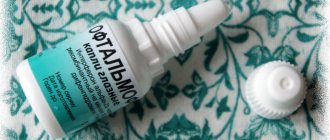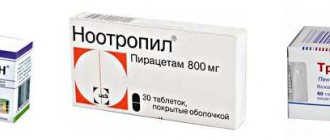How to use drops correctly?
The active substance of the drops is phenylephrine. With its vasoconstrictive properties, it is used not only to treat the eyes, but is also found in allergy and cold medications. This is an effective remedy for nasopharyngeal congestion.
Phenylephrine is used by injection for low pressure in the arteries and weak tone of the vascular wall. In ophthalmology it is used as “Irifrin” in two cases - in diagnosis and therapy.
In diagnostic practice, these drops are prescribed to dilate the pupil before surgery and examine the fundus, as well as determine the depth of the bulbus oculi injection and test for angle-closure glaucoma.
The drug "Irifrin" at a concentration of 2.5% and 10% is used as follows.
- To check the fundus oculi, the doctor prescribes a drop of medicine in each eye. Then, after 15-30 minutes, the pupil should dilate enough to conduct an examination. If the procedure lasts more than an hour, the instillation is repeated. If the pupil is not dilated enough, you need to use a stronger 10% composition.
- The test for angle-closure glaucoma will require 2.5% phenylephrine. First, the doctor measures the eye pressure, after which he instills the drug. He then compares the measurement results - before and after the procedure. With a difference of 3-5 mm Hg, pathology occurs.
- The depth of injection of the eyeball is determined using Irifrin 2.5%. After instillation, wait five minutes and check the result. The disappearance of redness indicates its superficial nature. If hyperemia persists, it spreads to deeper layers. Then a differential diagnosis of the identified pathology is carried out.
- Only 10% phenylephrine is suitable for preparation for surgery. It is administered drop by drop into both eyes 30-60 minutes before surgical procedures.
In what cases will Irifrin be effective? These drops are prescribed for the treatment of glaucomocyclic crisis (10% composition), red eye syndrome (2.5%), false myopia and iridocyclitis. Let's consider these pathologies in more detail.
- Glaucomocyclic crisis is manifested by fluctuations in intraocular pressure and signs of cyclitis (hyperemia, blurred vision, night pain, increased lacrimation).
- Red eye syndrome is caused by vasodilation or hemorrhage in the visual organs. It is characteristic of a number of pathologies caused by allergies, viruses and bacteria. Taking into account the symptoms that appear, the specialist diagnoses the disease.
- The spasm of accommodation is accompanied by a prolonged contraction of the focusing muscle. Otherwise, this condition is called false myopia, which is manifested by chronic tension of the musculus ciliaris. This disease, typical of schoolchildren, is considered curable, but over the years it often develops into true myopia.
- Iridocyclitis is an inflammation of the iris or middle choroid. Its symptoms are redness, swelling, changes in the shape of the pupil, eye pain and blurred vision.
For glaucomocyclic crises, Irifrin 10% is usually used, instilled 2-3 times a day. In the case of iridocyclitis, the drug removes fluid formed due to inflammation. In this case, drops of 2.5% and 10% are prescribed in a similar dose with the same frequency. The concentration of the active substance in the solution is determined by an ophthalmologist.
To get rid of false myopia, phenylephrine 2.5% is perfect. It is used daily, a drop in both eyes. The duration of the course is one month. If the problem is not resolved and the spasm is not relieved, increase the dose to 10% and take the drops for two weeks.
"Irifrin" in childhood
For children under 12 years of age, the drug is prescribed for visual impairment if a diagnosis of farsightedness or myopia is made. When a child comes to school, lessons and electives are added to his usual workload. The eyes are under stress and often in the first grades children complain of fatigue and blurred vision.
To avoid this, you need to teach your child to take short breaks when doing homework and watching TV. And at school you can do an exercise to train your eyes, turning your gaze to distant and close objects. This will benefit the baby.
Against the background of increased loads, Irifrin is used as a monthly course, drops at night in both eyes. You can prescribe two drops every other day. After a course of treatment, lacrimation and pain go away, and fatigue decreases.
Usually, the use of the drug prevents vision loss. To avoid switching to contact lenses or glasses, you need to teach children to take care of their eyes and listen to their feelings. As soon as fatigue appears, you need to take a break, do eye exercises or do a neutral activity. These techniques will help you avoid heavy loads.
Irifrin medicinal drops for children
In childhood, including preschoolers and children of primary school age, they are prescribed for the treatment of myopia and farsightedness. A child who has just entered school adds classroom and extracurricular activities to his usual visual load (TV, Internet). This is a lot of stress for the visual organs; often the first years of education are accompanied by eye fatigue and decreased vision. This process can be prevented by teaching your child to take short breaks while watching movies and doing homework. And in school lessons, the habit of looking out the window and shifting your gaze from close objects to more distant objects will be a useful contribution to eye health.
Irifrin drops are prescribed in courses against the background of stress. The course of treatment is thirty days, they are instilled at night, one drop in each eye daily, or two drops in each eye every other day. After the course of treatment, the symptoms of fatigue go away, the eyes stop hurting, watering and getting very tired. Often, thanks to the use of drops, the process of vision loss can be stopped. And in order to prevent wearing glasses and contacts, it is important to instill in your child the right attitude towards eye health and teach him to listen to his feelings. If fatigue appears, at the first opportunity you need to take a break, do gymnastics or do something neutral for the eyes - this approach solves the problem of systemic stress.
How does Irifrin work?
When instilling the drug, a slight burning sensation is felt, which disappears after 4-5 seconds. After this, you need to refrain from visual stress for two to three hours. You cannot write, read, work on a computer, watch TV, sew, knit, etc. 15-20 minutes after the procedure, eye accommodation deteriorates, objects become blurred, and bright light causes discomfort. This condition may last for several hours. Doctors recommend instilling Irifrin at night to minimize discomfort.
After using the drops, some patients suffering from hypertension note an increase in blood pressure. This side effect passes quickly and is not a cause for concern. Fans of contact lenses should refrain from wearing them during therapy and use glasses. After a few days you can return to them again. You need to prepare yourself for the fact that after a course of treatment with phenylephrine, your vision will be blurred for another three days. Then everything will get better, and your eyes will see even better.
By constantly using the drug, people note the disappearance of pain and a decrease in eye fatigue. If vision loss is not far from the norm, thanks to Irifrin drops, you can even remove your glasses in the future.
In addition, useful habits - control over eye hygiene, walks in the air and relaxing exercises, alternation of work and rest - will provide the visual organs with normal blood circulation in order to consolidate the therapeutic effect.
What happens after using Irifrin?
Immediately after instilling the drops, a burning sensation occurs in the eye. After a few seconds it goes away and the discomfort ends. After using the drug, do not strain your eyes for two to three hours: reading, writing, doing handicrafts, watching TV or using a computer. After fifteen to twenty minutes, visual functions deteriorate, visible objects are blurred, and the light blinds the eyes. This state persists for several hours. Irifrin drops are used before bedtime so that their effect falls on the inactive phase of the day.
People whose list of diseases includes hypertension can feel or record an increase in blood pressure a few minutes after instilling drops. This effect passes quickly, so there is no need to take any measures or worry. People who wear contact lenses will have to give them up during the course of treatment and switch to glasses. You can return to lenses again after a three to four day break. You should also be prepared for the fact that after a course of treatment with Irifrin, your vision will be blurry and not entirely clear for one to three days. However, visual function improves, and the eyes begin to see better than before treatment.
By regularly using Irifrin, you will notice that the pain goes away and your eyes get less tired in the evening. If vision does not deviate too much from the healthy norm, Irifrin drops can improve it so that you no longer have to wear glasses. Healthy habits regarding eye hygiene, work and rest schedules, walks, exercises, thanks to which the visual organs are provided with the necessary amount of blood and oxygen, will help maintain and consolidate the positive effect of the drug.
How is the drug released?
Irifrin drops are sold in 5 mm bottles. Once opened, they are suitable for use for another three months. The drug is used as prescribed by a doctor and strictly according to the instructions. You need to tilt your head back, open your lower eyelid and from a short distance squeeze a drop of the composition into each eye. In this case, it is not advisable to touch the mucous membrane with the bottle. If the solution gets on this area, adjust the inner edge of the eye so that it does not soak into where it is not needed. And remember about a gentle regime, avoiding visual stress after phenylephrine.
Precautionary measures
When a high dose of phenylephrine is administered, it quickly enters the bloodstream and causes unpleasant effects. The risk increases during the post-traumatic period of eye recovery, as well as with a lack of tear fluid.
In addition, doctors recommend careful use of the drug for patients with diabetes and the elderly. Diabetics have a high risk of hypertensive crisis, and in people over 65, the pupil may behave inappropriately and quickly shrink instead of the desired expansion.
Summarize. The active component phenylephrine compresses blood vessels and improves the removal of intraocular fluid. Due to the narrowing, the symptom of red eyes is relieved, and the rapid outflow of fluid brings relief from glaucoma. In addition, phenylephrine has been successfully used for diagnosis and preparation for operations, being an effective pupil dilator.
special instructions
When Irifrin is instilled more than two drops into each eye, increased absorption of the drug into the blood may occur, which will lead to side effects. The risk is especially high during recovery from eye injuries or when tear levels are low. When using the drug, caution is recommended for diabetics and people over sixty-five years of age. Diabetes mellitus can cause an increase in blood pressure, and in old age there is a possibility of a sharp narrowing of the pupil instead of the necessary dilation.
So, the active ingredient of Irifrin drops accelerates the process of outflow of intraocular fluid and constricts blood vessels. Thanks to their narrowing, red eye syndrome disappears, and increased outflow of intraocular fluid improves the condition of patients with glaucoma. Irifrin is a drop that promotes pupil dilation; this effect is used in diagnostic procedures, as well as in preoperative preparation.





